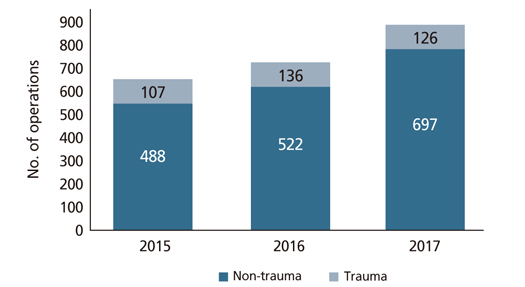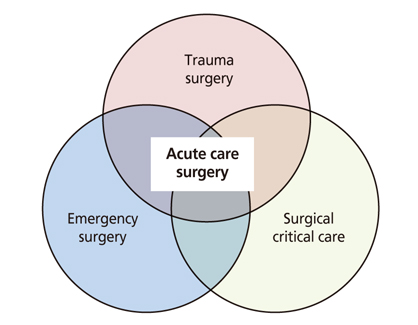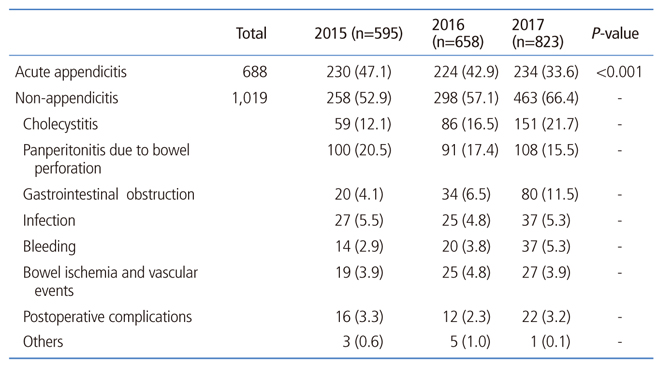 |
 |
- Search
| J Korean Med Assoc > Volume 62(2); 2019 > Article |
|
Abstract
Abdominal sepsis is mainly caused by intra-abdominal or retroperitoneal infection; therefore, early detection of the source of infection and adequate, prompt treatment are the most important contributors to patient outcomes. Because patients with sepsis often receive emergency abdominal surgery after regular hours, and most patients need critical care postoperatively, the need for personnel to specialize in these areas has emerged. The concept of acute care surgery (ACS), which includes trauma care, emergency general surgery, and surgical critical care, has been discussed since the early 2000s, and ACS fellowships were launched in the United States in 2008. ACS teams have been found to reduce mortality and complication rates, to decrease the time to surgery, and to lower financial costs in comparison to the traditional surgical model. In Korea, a regional trauma center project was started in 2012, and the government provided funding for each trauma center as part of this project. In the ACS field, the system for non-trauma emergency surgery is currently in the early stages of discussion. The need for such a system has been accelerated by the reduction of working hours per week of residents, as well as the shortage of manpower for emergency general surgery and surgical critical care on the night shift. In this review, we discuss the manpower problems that impact the treatment of abdominal emergency patients, and consider ways in which the Korean ACS system can treat these patients professionally.
References
1. Sartelli M, Viale P, Catena F, Ansaloni L, Moore E, Malangoni M, Moore FA, Velmahos G, Coimbra R, Ivatury R, Peitzman A, Koike K, Leppaniemi A, Biffl W, Burlew CC, Balogh ZJ, Boffard K, Bendinelli C, Gupta S, Kluger Y, Agresta F, Di Saverio S, Wani I, Escalona A, Ordonez C, Fraga GP, Junior GA, Bala M, Cui Y, Marwah S, Sakakushev B, Kong V, Naidoo N, Ahmed A, Abbas A, Guercioni G, Vettoretto N, Díaz-Nieto R, Gerych I, Tranà C, Faro MP, Yuan KC, Kok KY, Mefire AC, Lee JG, Hong SK, Ghnnam W, Siribumrungwong B, Sato N, Murata K, Irahara T, Coccolini F, Segovia Lohse HA, Verni A, Shoko T. 2013 WSES guidelines for management of intra-abdominal infections. World J Emerg Surg 2013;8:3.




2. Hoyt DB, Kim HD, Barrios C. Acute care surgery: a new training and practice model in the United States. World J Surg 2008;32:1630-1635.



4. Goslings JC, Ponsen KJ, Luitse JS, Jurkovich GJ. Trauma surgery in the era of nonoperative management: the Dutch model. J Trauma 2006;61:111-114.


5. Handolin L, Leppaniemi A, Vihtonen K, Lakovaara M, Lin-dahl J. Finnish Trauma Audit 2004: current state of trauma management in Finnish hospitals. Injury 2006;37:622-625.


6. Goosen J, Veller M. Trauma and emergency surgery: South African model. World J Surg 2008;32:1622-1625.



7. American Association for the Surgery of Trauma. Acute care surgery [Internet] Chicago: American Association for the Surgery of Trauma. 2014;cited 2019 Jan 29. Available from: http://www.aast.org/AcuteCareSurgery.aspx
8. Chana P, Burns EM, Arora S, Darzi AW, Faiz OD. A systematic review of the impact of dedicated emergency surgical services on patient outcomes. Ann Surg 2016;263:20-27.


9. Khalil M, Pandit V, Rhee P, Kulvatunyou N, Orouji T, Tang A, O'Keeffe T, Gries L, Vercruysse G, Friese RS, Joseph B. Certified acute care surgery programs improve outcomes in patients undergoing emergency surgery: a nationwide analysis. J Trauma Acute Care Surg 2015;79:60-63.

10. Park DJ, Park CY, Cho HM, Lee KH, Han HS. Current status and future prospects of trauma centers in Korea. J Korean Med Assoc 2017;60:530-532.


11. Jang JY, Shim H, Kwon HY, Chung H, Jung PY, Kim S, Ryu H, Bae KS. Improvement of outcomes in patients with pelvic fractures and hemodynamic instability after the establishment of a Korean regional trauma center. Eur J Trauma Emerg Surg 2017;12. 27. [Epub]. https://doi.org/10.1007/s00068-017-0886-3

12. Jung K, Matsumoto S, Smith A, Hwang K, Lee JC, Coimbra R. Comparison of outcomes in severely injured patients between a South Korean trauma center and matched patients treated in the United States. Surgery 2018;164:482-488.


13. Kim OH, Roh YI, Kim HI, Cha YS, Cha KC, Kim H, Hwang SO, Lee KH. Reduced mortality in severely injured patients using hospital-based helicopter emergency medical services in interhospital transport. J Korean Med Sci 2017;32:1187-1194.




14. Cherry-Bukowiec JR, Miller BS, Doherty GM, Brunsvold ME, Hemmila MR, Park PK, Raghavendran K, Sihler KC, Wahl WL, Wang SC, Napolitano LM. Nontrauma emergency surgery: optimal case mix for general surgery and acute care surgery training. J Trauma 2011;71:1422-1426.


Figure 2
Emergency abdominal operations at our center. Since the establishment of the regional trauma center in 2015, there has been a slight increase in the number of abdominal trauma operations and a steep increase in the number of non-trauma abdominal operations.

- TOOLS










